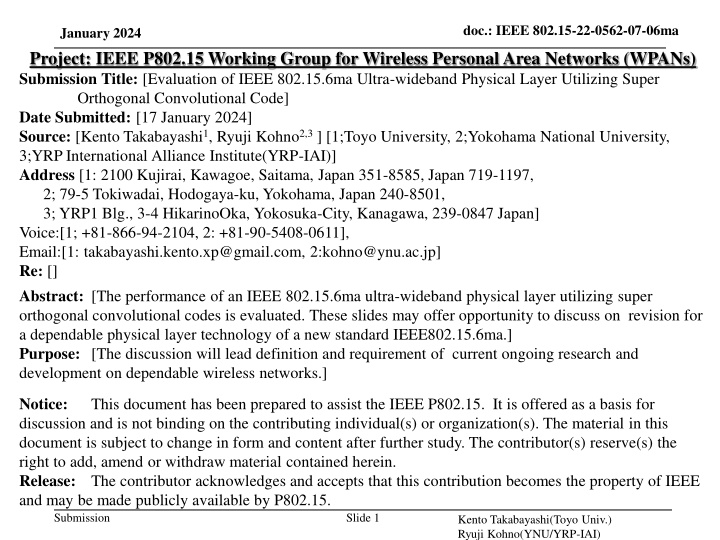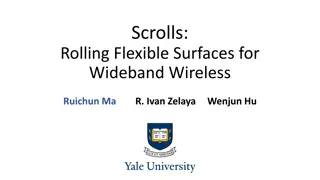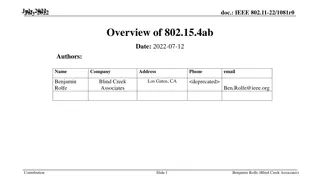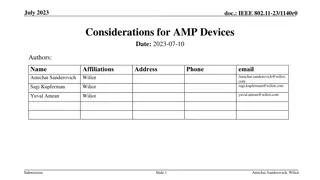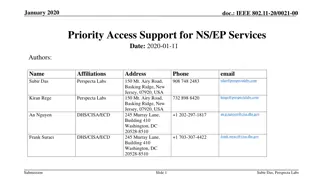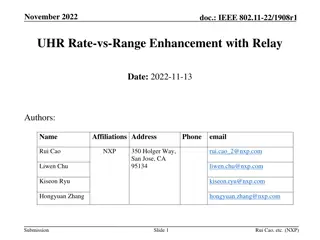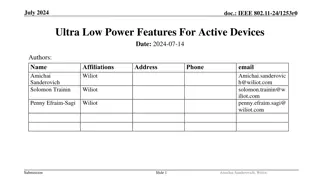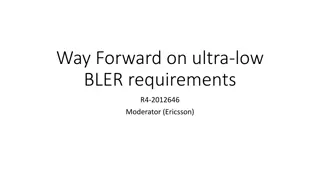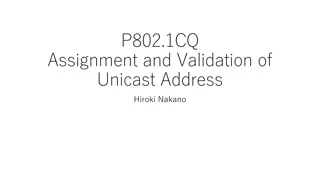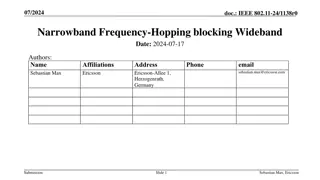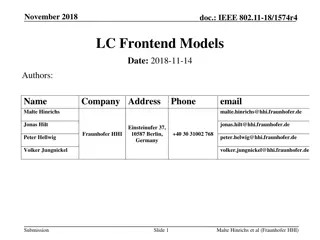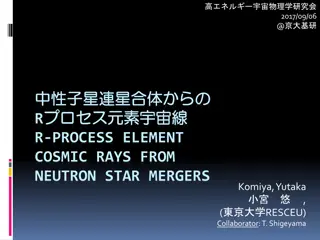Evaluation of IEEE 802.15.6ma Ultra-wideband Physical Layer
The performance of IEEE 802.15.6ma ultra-wideband physical layer utilizing Super Orthogonal Convolutional Codes is assessed for dependable wireless networks. Explore the application of Super Orthogonal Convolutional Codes in improving reliability in IEEE 802.15.6 UWB physical layer.
Download Presentation

Please find below an Image/Link to download the presentation.
The content on the website is provided AS IS for your information and personal use only. It may not be sold, licensed, or shared on other websites without obtaining consent from the author.If you encounter any issues during the download, it is possible that the publisher has removed the file from their server.
You are allowed to download the files provided on this website for personal or commercial use, subject to the condition that they are used lawfully. All files are the property of their respective owners.
The content on the website is provided AS IS for your information and personal use only. It may not be sold, licensed, or shared on other websites without obtaining consent from the author.
E N D
Presentation Transcript
doc.: IEEE 802.15-22-0562-07-06ma January 2024 Project: IEEE P802.15 Working Group for Wireless Personal Area Networks (WPANs) Submission Title: [Evaluation of IEEE 802.15.6ma Ultra-wideband Physical Layer Utilizing Super Orthogonal Convolutional Code] Date Submitted: [17 January 2024] Source: [Kento Takabayashi1, Ryuji Kohno2,3] [1;Toyo University, 2;Yokohama National University, 3;YRP International Alliance Institute(YRP-IAI)] Address [1: 2100 Kujirai, Kawagoe, Saitama, Japan 351-8585, Japan 719-1197, 2; 79-5 Tokiwadai, Hodogaya-ku, Yokohama, Japan 240-8501, 3; YRP1 Blg., 3-4 HikarinoOka, Yokosuka-City, Kanagawa, 239-0847 Japan] Voice:[1; +81-866-94-2104, 2: +81-90-5408-0611], Email:[1: takabayashi.kento.xp@gmail.com, 2:kohno@ynu.ac.jp] Re: [] Abstract: [The performance of an IEEE 802.15.6ma ultra-wideband physical layer utilizing super orthogonal convolutional codes is evaluated. These slides may offer opportunity to discuss on revision for a dependable physical layer technology of a new standard IEEE802.15.6ma.] Purpose: [The discussion will lead definition and requirement of current ongoing research and development on dependable wireless networks.] Notice: discussion and is not binding on the contributing individual(s) or organization(s). The material in this document is subject to change in form and content after further study. The contributor(s) reserve(s) the right to add, amend or withdraw material contained herein. Release: The contributor acknowledges and accepts that this contribution becomes the property of IEEE and may be made publicly available by P802.15. This document has been prepared to assist the IEEE P802.15. It is offered as a basis for Submission Slide 1 Kento Takabayashi(Toyo Univ.) Ryuji Kohno(YNU/YRP-IAI)
doc.: IEEE 802.15-22-0562-07-06ma January 2024 Evaluation of IEEE 802.15.6ma Ultra-wideband Physical Layer Utilizing Super Orthogonal Convolutional Code January 2024, Hybrid Session , Hilton - Panama City, Panama Kento Takabayashi1, Ryuji Kohno2,3 1. Toyo University, Japan 2. Yokohama National University, Japan 3. YRP International Alliance Institute, Japan Submission Slide 2 Kento Takabayashi(Toyo Univ.) Ryuji Kohno(YNU/YRP-IAI)
doc.: IEEE 802.15-22-0562-07-06ma January 2024 1. Motivation and Aim of study UWB is a promising technology that may satisfy the requirements of IoMT IEEE 802.15.6 UWB PHY has limited transmission output and requires to ensure dependability New consideration is given to the application of Super Orthogonal Convolutional Codes (SOCC) as a technique for improving dependability for higher priority case We perform evaluation when SOCC is applied at the IEEE 802.15.6 UWB PHY, and confirm the effectiveness of these combinations Submission 3 Kento Takabayashi(Toyo Univ.) Ryuji Kohno(YNU/YRP-IAI)
doc.: IEEE 802.15-22-0562-07-06ma January 2024 3. SOCC Fig. SOCC encoder SOCC is a kind of orthogonal convolutional code of very low coding rate The encoder is composed of K length shift registers (constraint length) and a block orthogonal (Hadamard) encoder The coding rate is given by ?????= ?? ? The decoder uses the Viterbi algorithm ? Submission 4 Kento Takabayashi(Toyo Univ.) Ryuji Kohno(YNU/YRP-IAI)
doc.: IEEE 802.15-22-0562-07-06ma January 2024 3. Application of SOCCs to IEEE 802.15.6 UWB PHY Procedure for applying an SOCC Fig. Block diagrams showing the procedure for applying an SOCC to the IEEE 802.15.6 UWB PHY For the PHR, after the CRC encoding of the PHR frame, whether to apply the shortened BCH code is determined, and then, whether to apply an SOCC is determined Similarly, for the PSDU, after the CRC encoding of the MAC header and MAC frame body, whether to apply the BCH code is determined, and then, whether to apply an SOCC is determined Concatenated encoding using the BCH code as the outer code and an SOCC as the inner code is performed when both the BCH code and SOCC are applied Submission Kento Takabayashi(Toyo Univ.) Ryuji Kohno(YNU/YRP-IAI) Slide 5
doc.: IEEE 802.15-22-0562-07-06ma January 2024 4. Evaluation 4. Evaluation Table. Simulation Parameters Channel model AWGN, IEEE model CM3 Pass loss model IEEE model CM3 Bandwidth (BW) 499.2 MHz Center Frequency 3993.6 MHz Modulation DBPSK Transmission power (???) Thermal noise density (?0) Implementation losses (?) Receiver noise figure (??) 0 dBm ??? -174 dBm/Hz 3 dB 5 dB FEC (PHR) (40, 28) Shortened BCH code, (11, 5) Shortened Reed- Solomon (RS) code, SOCC (K=3~7) FEC (PSDU) (63, 51) BCH code, (31, 25) Reed-Solomon (RS) code, SOCC (K=3~7) Communication distance (?) 0.5 m Pulse waveform duration (??) Information bit length (?????) 2.003 ns 540 bits Pulse option Single pulse option, burst pulse option Submission Slide 6 Kento Takabayashi(Toyo Univ.) Ryuji Kohno(YNU/YRP-IAI)
doc.: IEEE 802.15-22-0562-07-06ma January 2024 4. Evaluation Red line: ????= 41.3 dBm/MHz Fig. Transmission failure ratio as a function of the transmission power (IEEE model CM3 BCH encoding) Submission Slide 7 Kento Takabayashi(Toyo Univ.) Ryuji Kohno(YNU/YRP-IAI)
doc.: IEEE 802.15-22-0562-07-06ma January 2024 4. Evaluation Red line: ????= 41.3 dBm/MHz Fig. Transmission failure ratio as a function of the transmission power (IEEE model CM3 RS encoding) Submission Slide 8 Kento Takabayashi(Toyo Univ.) Ryuji Kohno(YNU/YRP-IAI)
doc.: IEEE 802.15-22-0562-07-06ma January 2024 4. Result The overall tendency was for the performance of the IEEE model CM3 to deteriorate compared to that of the AWGN channel due to the effect of multipath fading When the constraint length of the SOCC increased, the transmission failure ratio improved because the error-correcting capability increased with decreasing ????? On the other hand, the energy efficiency decreased because the number of redundant bits in the PPDU increased There was almost no difference between the applications of the concatenated coding of BCH codes and an SOCC and a single SOCC when ?????= 1/8 or less in the former An improvement effect was seen even at ?????= 1/32 in the case of the concatenated coding of RS codes and an SOCC Submission Slide 9 Kento Takabayashi(Okayama Pref. Univ.) Ryuji Kohno(YNU/YRP-IAI)
doc.: IEEE 802.15-22-0562-07-06ma January 2024 4. Discussion Single Pulse Option The transmission failure ratio is focused on when meeting the UWB usage limitation such that BW = 499.2 MHz and ????= 41.3 dBm/MHz (transmission power of -14.3 dBm) Under the above conditions, the transmission failure ratio was more than 10 1 unless an SOCC was applied, which means that sufficient reliability cannot be ensured by the current standard in the case of the single pulse option Then, the transmission failure ratio was below 10 1when ?????= 1/2 and below 10 2when ?????= 1/8 RS encoding obtained better results than BCH encoding The compared RS code has better error-correcting capabilities than the BCH code specified in the standard The RS code can be expected to correct burst errors that occur during SOCC decoding since the RS code is a burst error-correcting code Submission Slide 10 Kento Takabayashi(Toyo Univ.) Ryuji Kohno(YNU/YRP-IAI)
doc.: IEEE 802.15-22-0562-07-06ma January 2024 5. Conclusion Numerical results showed that sufficient dependability could not be ensured by the error control method defined by IEEE 802.15.6 and that high energy efficiency was obtained while ensuring a sufficient transmission failure ratio by applying an SOCC It was also confirmed that a combination effect could be obtained with an SOCC by applying RS codes with almost the same coding rate as the BCH code specified in IEEE 802.15.6 SOCC has potential to be applied to more important user priority case because of the powerful error correcting capability but very low coding rate Submission Slide 11 Kento Takabayashi(Toyo Univ.) Ryuji Kohno(YNU/YRP-IAI)
doc.: IEEE 802.15-22-0562-07-06ma November 2023 Reference Kento Takabayashi, Hirokazu Tanaka, Katsumi Sakakibara, "Evaluation of Wireless Body Area Network Utilizing Super Orthogonal Convolutional Code," in Proceedings of 2019 International Symposium on Intelligent Signal Processing and Communication Systems (ISPACS 2019), Beitou, Taipei, Taiwan, pp.1-2, Dec. 2019. Kento Takabayashi, Hirokazu Tanaka, Katsumi Sakakibara, "Toward Dependable Internet of Medical Things: IEEE 802.15.6 Ultra-Wideband Physical Layer Utilizing Superorthogonal Convolutional Code," Sensors, 2022, vol. 22, no. 6, 2172, Mar. 2022. Submission Slide 12 Kento Takabayashi(Toyo Univ.) Ryuji Kohno(YNU/YRP-IAI)
doc.: IEEE 802.15-22-0562-07-06ma January 2024 Thank you for your attention ! ! ! * This research was funded by JSPS Grant-in-Aid for Early-Career Scientists Grant Number JP20K14737 Submission Slide 13 Kento Takabayashi(Toyo Univ.) Ryuji Kohno(YNU/YRP-IAI) 13
doc.: IEEE 802.15-22-0562-07-06ma January 2024 2. IEEE 802.15.6 UWB PHY Pulse option Transmitting signal ? ??? ? ????? (?)?? ? ? = ?=0 ? ? (Single Pulse Option,??= ??) ???? 1 ? ? = 1 2??? ? ??? ?=0 (Burst Pulse Option,??= ??????) Fig. Signal transmission example where the burst pulse option is used Single pulse option: A single pulse transmitted per symbol Burst pulse option: A concatenation of ????pulses transmitted per symbol This option improves the received power by correlating multiple pulses while decreasing the uncoded bit rate as ????increases Submission Slide 14 Kento Takabayashi(Toyo Univ.) Ryuji Kohno(YNU/YRP-IAI)
doc.: IEEE 802.15-22-0562-07-06ma January 2024 2. IEEE 802.15.6 UWB PHY Frequency spectrum High Band Low Band 0 2 10 1 3 6 frequency ? bandwidth 499.2 MHz 3993.6 MHz 7987.2 MHz The UWB band is divided into two band groups: low band (channel 0-2) and high band (channel 3-10) which are divided into operating frequency channels with 499.2 MHz bandwidth Orange colors are mandatory channels (Low Band: channel 1 High Band: channel 6) The power spectral density emission limit is -41.3 dBm/MHz which is very low Submission Slide 15 Kento Takabayashi(Toyo Univ.) Ryuji Kohno(YNU/YRP-IAI)
doc.: IEEE 802.15-22-0562-07-06ma January 2024 2. IEEE 802.15.6 UWB PHY Frame format SHR is divided into two parts: The first part is the preamble, intended for timing synchronization, packet detection, and carrier frequency offset recovery, and The second part is the start-of-frame delimiter (SFD) for frame synchronization The PHR contains information about the data rate of the PSDU, length of the medium access control (MAC) frame body, pulse shape, burst mode, and so on The PSDU contains the MAC protocol data unit (MPDU) Submission Slide 16 Kento Takabayashi(Toyo Univ.) Ryuji Kohno(YNU/YRP-IAI)
doc.: IEEE 802.15-22-0562-07-06ma January 2024 2. IEEE 802.15.6 UWB PHY ????is the power of two As ????increases, a uncoded bit rate decreases Uncoded bit rate and received signal to noise ratio (SNR) are in a trade-off relationship Submission Slide 17 Kento Takabayashi(Toyo Univ.) Ryuji Kohno(YNU/YRP-IAI)
